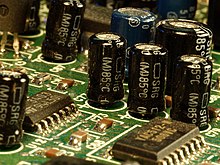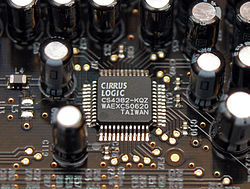Sound card
From Wikipedia, the free encyclopedia
 A Sound Blaster Live! Value card, a typical (circa 2000) PCI sound card. | |
| Connects to | Motherboard via one of:
|
|---|---|
| Common manufacturers | Creative Labs (and subsidiary E-mu Systems) Realtek C-Media M-Audio Turtle Beach |
Contents[hide] |
[edit] General characteristics

Close-up of a sound card PCB, showing electrolytic capacitors, SMT capacitors and resistors, and a YAC512 two-channel 16-bit DAC.
Most sound cards have a line in connector for signal from a cassette tape recorder or similar sound source. The sound card digitizes this signal and stores it (under control of appropriate matching computer software) on the computer's hard disk for storage, editing, or further processing. Another common external connector is the microphone connector, for use by a microphone or other low level input device. Input through a microphone jack can then be used by speech recognition software or for Voice over IP applications.
[edit] Sound channels and polyphony
An important characteristic of sound cards is polyphony, which is more than one distinct voice or sound playable simultaneously and independently, and the number of simultaneous channels. These are intended as the number of distinct electrical audio outputs, which may correspond to a speaker configuration such as 2.0 (stereo), 2.1 (stereo and sub woofer), 5.1 etc. Sometimes, the terms "voices" and "channels" are used interchangeably to indicate the degree of polyphony, not the output speaker configuration.For example, many older sound chips could accommodate three voices, but only one audio channel (ie, a single mono output) for output, requiring all voices to be mixed together. Later cards, such as the AdLib sound card, had a 9 voice polyphony and 1 mono channel as a combined output.
For some years, most PC sound cards have had multiple FM synthesis voices (typically 9 or 16) which were usually used for MIDI music. The full capabilities of advanced cards aren't often completely used; only one (mono) or two (stereo) voice(s) and channel(s) are usually dedicated to playback of digital sound samples, and playing back more than one digital sound sample usually requires a software downmix at a fixed sampling rate. Modern low-cost integrated soundcards (ie, those built into motherboards) such as audio codecs like those meeting the AC'97 standard and even some budget expansion soundcards still work that way. They may provide more than two sound output channels (typically 5.1 or 7.1 surround sound), but they usually have no actual hardware polyphony for either sound effects or MIDI reproduction, these tasks are performed entirely in software. This is similar to the way inexpensive softmodems perform modem tasks in software rather than in hardware).
Also, in the early days of wavetable synthesis, some sound card manufacturers advertised polyphony solely on the MIDI capabilities alone. In this case, the card's output channel is irrelevant (and typically, the card is only capable of two channels of digital sound). Instead, the polyphony measurement solely applies to the amount of MIDI instruments the sound card is capable of producing at one given time.
Today, a sound card providing actual hardware polyphony, regardless of the number of output channels, is typically referred to as a "hardware audio accelerator", although actual voice polyphony is not the sole (or even a necessary) prerequisite, with other aspects such as hardware acceleration of 3D sound, positional audio and real-time DSP effects being more important.
Since digital sound playback has become available and provided better performance than synthesis, modern soundcards with hardware polyphony don't actually use DACs with as many channels as voices. Instead, they perform voice mixing and effects processing in hardware (eventually performing digital filtering and conversions to and from the frequency domain for applying certain effects) inside a dedicated DSP. The final playback stage is performed by an external (in reference to the DSP chip(s)) DAC with significantly fewer channels than voices (e.g., 8 channels for 7.1 audio, which can be divided among 32, 64 or even 128 voices).
[edit] Color codes
Connectors on the sound cards are colour coded as per the PC System Design Guide. They will also have symbols with arrows, holes and soundwaves that are associated with each jack position, the meaning of each is given below:| Colour | Function | Connector | symbol | |
|---|---|---|---|---|
| Pink | Analog microphone audio input. | 3.5 mm TRS | A microphone | |
| Light blue | Analog line level audio input. | 3.5 mm TRS | An arrow going into a circle | |
| Lime green | Analog line level audio output for the main stereo signal (front speakers or headphones). | 3.5 mm TRS | Arrow going out one side of a circle into a wave | |
| Brown/Dark | Analog line level audio output for a special panning,'Right-to-left speaker'. | 3.5 mm TRS | ||
| Black | Analog line level audio output for surround speakers, typically rear stereo. | 3.5 mm TRS | ||
| Orange | Analog line level audio output for center channel speaker and subwoofer | 3.5 mm TRS | ||
| Gold/Grey | Game port / MIDI | 15 pin D | Arrow going out both sides into waves | |
[edit] History of sound cards for the IBM PC architecture

The AdLib Music Synthesizer Card, was one of the first sound cards circa 1990. Note the manual volume adjustment knob.

A sound card based on VIA Envy chip.
It is important to note that the initial design and marketing focuses of sound cards for the IBM PC platform were not based on gaming, but rather on specific audio applications such as music composition (AdLib Personal Music System, Creative Music System, IBM Music Feature Card) or on speech synthesis (Digispeech DS201, Covox Speech Thing, Street Electronics Echo). Not until Sierra and other game companies became involved in 1988 was there a switch toward gaming.
[edit] Hardware manufacturers
One of the first manufacturers of sound cards for the IBM PC was AdLib, who produced a card based on the Yamaha YM3812 sound chip, also known as the OPL2. The AdLib had two modes: A 9-voice mode where each voice could be fully programmed, and a less frequently used "percussion" mode with 3 regular voices producing 5 independent percussion-only voices for a total of 11. (The percussion mode was considered inflexible by most developers; it was used mostly by AdLib's own composition software.)Creative Labs also marketed a sound card about the same time called the Creative Music System. Although the C/MS had twelve voices to AdLib's nine, and was a stereo card while the AdLib was mono, the basic technology behind it was based on the Philips SAA 1099 chip which was essentially a square-wave generator. It sounded much like twelve simultaneous PC speakers would have, and failed to sell well, even after Creative renamed it the Game Blaster a year later, and marketed it through Radio Shack in the US. The Game Blaster retailed for under $100 and included the hit game Silpheed.
A large change in the IBM PC compatible sound card market happened with Creative Labs' introduced the Sound Blaster card. The Sound Blaster cloned the AdLib, and added a sound coprocessor for recording and play back of digital audio (likely to have been an Intel microcontroller relabeled by Creative). It was incorrectly called a "DSP" (to suggest it was a digital signal processor), a game port for adding a joystick, and capability to interface to MIDI equipment (using the game port and a special cable). With more features at nearly the same price, and compatibility as well, most buyers chose the Sound Blaster. It eventually outsold the AdLib and dominated the market.
The Sound Blaster line of cards, together with the first inexpensive CD-ROM drives and evolving video technology, ushered in a new era of multimedia computer applications that could play back CD audio, add recorded dialogue to computer games, or even reproduce motion video (albeit at much lower resolutions and quality in early days). The widespread decision to support the Sound Blaster design in multimedia and entertainment titles meant that future sound cards such as Media Vision's Pro Audio Spectrum and the Gravis Ultrasound had to be Sound Blaster compatible if they were to sell well. Until the early 2000s (by which the AC'97 audio standard became more widespread and eventually usurped the SoundBlaster as a standard due to its low cost and integration into many motherboards), Sound Blaster compatibility is a standard that many other sound cards still support to maintain compatibility with many games and applications released.
[edit] Industry adoption
When game company Sierra On-Line opted to support add-on music hardware (instead of built-in hardware such as the PC speaker and built-in sound capabilities of the IBM PCjr and Tandy 1000), what could be done with sound and music on the IBM PC changed dramatically. Two of the companies Sierra partnered with were Roland and Adlib, opting to produce in-game music for King's Quest 4 that supported the Roland MT-32 and Adlib Music Synthesizer. The MT-32 had superior output quality, due in part to its method of sound synthesis as well as built-in reverb. Since it was the most sophisticated synthesizer they supported, Sierra chose to use most of the MT-32's custom features and unconventional instrument patches, producing background sound effects (eg, chirping birds, clopping horse hooves, etc.) before the Sound Blaster brought playing real audio clips to the PC entertainment world. Many game companies also supported the MT-32, but supported the Adlib card as an alternative because of the latter's higher market base. The adoption of the MT-32 led the way for the creation of the MPU-401/Roland Sound Canvas and General MIDI standards as the most common means of playing in-game music until the mid-1990s.[edit] Feature evolution
Early ISA bus soundcards were half-duplex, meaning they couldn't record and play digitized sound simultaneously, mostly due to inferior card hardware (eg, DSPs). Later, ISA cards like the SoundBlaster AWE series and Plug-and-play Soundblaster clones eventually became full-duplex and supported simultaneous recording and playback, but at the expense of using up two IRQ and DMA channels instead of one, making them no different from having two half-duplex sound cards in terms of configuration. Towards the end of the ISA bus' life, ISA soundcards started taking advantage of IRQ sharing, thus reducing the IRQs needed to one, but still needed two DMA channels. Many PCI bus cards do not have these limitations and are mostly full-duplex. It should also be noted that many modern PCI bus cards also do not require free DMA channels to operate.Also, throughout the years, soundcards have evolved in terms of digital audio sampling rate (starting from 8-bit 11.025 kHz, to 32-bit, 192 kHz that the latest solutions support). Along the way, some cards started offering wavetable synthesis, which provides superior MIDI synthesis quality in relative to the earlier OPL-based solutions, which uses FM-synthesis. Also, some higher end cards started having its own RAM and processor for user-definable sound samples and MIDI instruments as well as to offload audio processing from the CPU.
For years, soundcards had only one or two channels of digital sound (most notably the Sound Blaster series and their compatibles) with the exception of the E-MU card family, which had hardware support for up to 32 independent channels of digital audio. Early games and MOD-players needing more channels than a card could support had to resort to mixing multiple channels in software. Even today, the tendency is still to mix multiple sound streams in software, except in products specifically intended for gamers or professional musicians, with a sensible difference in price from "software based" products. Also, in the early era of wavetable synthesis, soundcard companies would also sometimes boast about the card's polyphony capabilities in terms of MIDI synthesis. In this case polyphony solely refers to the amount of MIDI notes the card is capable of synthesizing simultaneously at one given time and not the amount of digital audio streams the card is capable of handling.
In regards to physical sound output, the number of physical sound channels has also increased. The first soundcard solutions were mono. Stereo sound was introduced in the early 90s, and quadraphonic sound came in the late 90s. This was shortly followed by 5.1 channel audio. The latest soundcards support up to 8 physical audio channels in the 7.1 speaker setup.
[edit] Professional soundcards (audio interfaces)
Professional soundcards are special soundcards optimized for real time (or at least low latency) multichannel sound recording and playback, including studio-grade fidelity. Their drivers usually follow the Audio Stream Input Output protocol for use with professional sound engineering and music software, although ASIO drivers are also available for a range of consumer-grade soundcards.Professional soundcards are usually described as "audio interfaces", and sometimes have the form of external rack-mountable units using USB 2.0, Firewire, or an optical interface, to offer sufficient data rates. The emphasis in these products is, in general, on multiple input and output connectors, direct hardware support for multiple input and output sound channels, as well as higher sampling rates and fidelity as compared to the usual consumer soundcard. In that respect, their role and intended purpose is more similar to a specialized multi-channel data recorder and real-time audio mixer and processor, roles which are possible only to a limited degree with typical consumer soundcards.
On the other hand, certain features of consumer soundcards such as support for environmental audio extensions, optimization for hardware acceleration in video games, or real-time ambience effects are secondary, nonexistent or even undesirable in professional soundcards, and as such audio interfaces are not recommended for the typical home user.
The typical "consumer-grade" soundcard is intended for generic home, office, and entertainment purposes with an emphasis on playback and casual use, rather than catering to the needs of audio professionals. In response to this, Steinberg (the creators of audio recording and sequencing software, Cubase and Nuendo) developed a protocol that specified the handling of multiple audio inputs and outputs.
In general, consumer grade soundcards impose several restrictions and inconvenieces that would be unacceptable to an audio professional. One of a modern soundcard's purposes is to provide an AD/DA converter (analog to digital/digital to analog). However, in professional applications, there is usually a need for enhanced recording (analog to digital) conversion capabilities.
One of the limitations of consumer soundcards is their comparatively large sampling latency; this is the time it takes for the AD Converter to complete conversion of a sound sample and transfer it to the computer's main memory.
Consumer soundcards are also limited in the effective sampling rates and bit depths they can actually manage (compare analog versus digital sound) and have lower numbers of less flexible input channels: professional studio recording use typically requires more than two channels which consumer soundcards provide, and more accessible connectors, unlike the variable mixture of internal -- and sometimes virtual -- and external connectors found in consumer-grade soundcards.
[edit] Sound devices other than expansion cards
[edit] Integrated sound hardware on PC motherboards
In 1984, the first IBM PCjr had only a rudimentary 3-voice sound synthesis chip (the SN76489) which was capable of generating three square-wave tones with variable amplitude, and a pseudo white noise channel that could generate primitive percussion sounds. The Tandy 1000, initially a clone of the PCjr, duplicated this functionality, with the Tandy TL/SL/RL models adding digital sound recording/playback capabilities.In the late 1990s, many computer manufacturers began to replace plug-in soundcards with a "codec" chip (actually a combined audio AD/DA-converter) integrated into the motherboard. Many of these used Intel's AC97 specification. Others used inexpensive ACR slot accessory cards.
As of 2005, these "codecs" usually lack the hardware for direct music synthesis or even multi-channel sound, with special drivers and software making up for these lacks, at the expense of CPU speed (for example, MIDI reproduction takes away 10-15% CPU time on an Athlon XP 1600+ CPU).
Nevertheless, some manufacturers offered (and offer, as of 2006) motherboards with integrated "real" (non-codec) soundcards, usually in the form of a custom chipset providing something akin to full ISA or PCI Soundblaster compatibility; this saves an expansion slot while providing the user with a (relatively) high quality soundcard.
[edit] Integrated sound on other platforms
Various non-IBM PC compatible computers, such as early home computers like the Commodore C64 and Amiga or Apple's Macintosh, and workstations from manufacturers like Sun have had their own motherboard integrated sound devices. In some cases, most notably in those of the Commodore Amiga and the C64, they provide very advanced capabilities (as of the time of manufacture), in others they are only minimal capabilities. Some of these platforms have also had sound cards designed for their bus architectures that cannot be used in a standard PC.The custom sound chip on Amiga, named Paula, had four digital sound channels (2 for the left speaker and 2 for the right) with 8 bit resolution (although with patches, 14/15bit was accomplishable at the cost of high CPU usage) for each channel and a 6 bit volume control per channel. Sound Play back on Amiga was done by reading directly from the chip-RAM without using the main CPU.
[edit] Sound cards on other platforms
The earliest known soundcard used by computers was the Gooch Synthetic Woodwind, A music device for PLATO terminals, and is widely hailed as the precursor to sound cards and MIDI. It was invented in 1972.While many of Apple's machines come with on-board sound capabilities, their bestselling Apple II series suffered from a lack of more than minimal sound devices, all but the last model containing only a beeper that was even more limited than the one in the PC. To get around the problem, the Sweet Micro Systems company developed the Mockingboard (a name-play on mockingbird), which was essentially a sound card for the Apple II. Early Mockingboard models ranged from 3 voices in mono, while some later designs were 6 voices in stereo. Some software supported use of two Mockingboard cards which allowed 12 voice music and sound. A 12 voice, single card clone of the Mockingboard called the Phasor was also made by Applied Engineering. In late 2005 a company called ReactiveMicro.com produced a 6 voice clone called the Mockingboard v1 and also has plans to clone the Phasor and produce a hybrid card which will be user selectable between Mockingboard and Phasor modes plus support both the SC-01 or SC-02 speech synthesizers.
MSX computers also relied on sound cards to produce better quality audio. The card, known as Moonsound, uses a Yamaha OPL4 sound chip. Prior to the Moonsound, there were also soundcards called MSX Music and MSX Audio, which uses OPL2 and OPL3 chipsets, for the system.
[edit] USB sound "cards"
USB sound "cards" are actually external boxes that plug into the computer via USB. They are more accurately called audio interfaces rather than sound cards.The USB specification defines a standard interface, the USB audio device class, allowing a single driver to work with the various USB sound devices on the market. Cards meeting the USB 2.0 specification have sufficient data transfer capacity to support high quality sound operation if their circuit design permits.
[edit] Other outboard sound devices
.USB Sound Cards are far from the first external devices allowing a computer to record or synthesize sound. For example, devices such as the Covox Speech Thing were attached to the parallel port of an IBM PC and fed 6- or 8-bit PCM sample data to produce audio. Also, many types of professional soundcards (audio interfaces) have the form of an external Firewire or USB unit, usually for convenience and improved fidelity.Soundcards using the PCMCIA cardbus interface were popular in the early days of portable computing when laptops and notebooks did not have onboard sound. Even today, while rare, these cardbus audio solutions are still used in some setups in which the onboard sound solution of the notebook or laptop is not up to par with the owners' expectations or requirements, and are particularly targeted at mobile DJs, with units providing separated outputs usually allow both playback and monitoring from one system.
[edit] Driver architecture
To use a sound card, the operating system typically requires a specific device driver. This is a low-level program that handles the data connections between the physical hardware and the operating system. Some operating systems include the drivers for some or all cards available, in other cases the drivers are supplied with the card itself, or are available for download.- DOS programs for the IBM PC often had to use universal middleware driver libraries (such as the HMI Sound Operating System, the Miles Audio Interface Libraries (AIL), the Miles Sound System etc.) which had drivers for most common sound cards, since DOS itself had no real concept of a sound card. Some card manufacturers provided (sometimes inefficient) middleware TSR-based drivers for their products. Often the driver is a SoundBlaster emulator designed to allow their products to emulate a SoundBlaster and to allow games that could only use SoundBlaster sound to work with the card. finally, some programs simply had driver/middleware source code incorporated into the program itself for the sound cards that were supported.
- Microsoft Windows uses proprietary drivers generally written by the sound card manufacturers. Many device manufacturers supply the drivers on their own discs or to Microsoft for inclusion on Windows installation disc. Sometimes drivers are also supplied by the individual vendors for download and installation. Bug fixes and other improvements are likely to be available faster via downloading, since CDs cannot be updated as frequently as a web or FTP site. USB audio device class support is present from Windows 98 SE onwards. [1] Since Microsoft's Universal Audio Architecture (UAA) initiative which supports the HD Audio, FireWire and USB audio device class standards, a universal class driver by Microsoft can be used. The driver is included with Windows Vista. For Windows XP, Windows 2000 or Windows Server 2003, the driver can be obtained by contacting Microsoft support. [2] Almost all manufacturer-supplied drivers for such devices also include this class driver.
- A number of versions of UNIX make use of the portable Open Sound System (OSS). Drivers are seldom produced by the card manufacturer.
- Most present day Linux-based distributions make use of the Advanced Linux Sound Architecture (ALSA). Up until Linux kernel 2.4, OSS was the standard sound architecture for Linux, although ALSA can be downloaded, compiled and installed separately for kernels 2.2 or higher). But from kernel 2.5 onwards, ALSA was integrated into the kernel and the OSS native drivers were deprecated. Backwards compatibility with OSS-based software is maintained, however, by the use of the ALSA-OSS compatibility API and the OSS-emulation kernel modules.
- Mockingboard support on the Apple II is usually incorporated into the programs itself as many programs for the Apple II boot directly from disk.
[edit] See also
- Computer hardware
- OMAP (TI)
- EAX
- ASIO
- Sound chip
- Audio signal processing
- Guitar effects unit
- Sound effect
- Stereo
- Dolby Digital (EX, Surround EX)
- S Logic
- SNR
- Texture (music)
- Audio Compression













.jpg)









